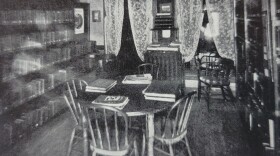Train tracks were laid into the northern Wisconsin wilderness from the 1850s onward and dominated transportation for well over 100 years. Like any mode of conveyance, trains were not without their share of accidents.
Although relatively slow moving, trains do not stop easily. No shortage of vehicles or persons came head-to-head with locomotives in their time, often with fatal effect. So too did trains occasionally collide with other trains. One such incident occurred at Rhinelander in the summer of 1951.
On July 4, 1951, a tandem of southbound diesels were headed for Chicago. It carried a train loaded down with taconite ore from Ironwood, Michigan. The ore train was scheduled to take a sidetrack at McNaughton, allowing the northbound Flambeau 400, a passenger train, to pass on its evening run. The crew of the ore hauler believed it could pass the yards at Rhinelander before the Flambeau continued its trek northward. Shortly after the 400 left the Chicago Northwestern Station at Rhinelander, it plowed head on into the ore train!
The two locomotives hauling the ore jackknifed upon impact and were badly damaged. Four of the ore cars were derailed causing taconite pellets to spill everywhere. The Flambeaus train cars miraculously stayed on the tracks, some of which were straddling the Wisconsin River on a bridge behind the paper mill, stifling more serious injuries to its passengers.
Both trains were traveling approximately fifteen miles per hour. The collision occurred near the Phillips Street crossing. Two of the ore train’s young crew, Ralph Crum and Willard Aird, both of Antigo, jumped off when the crash seemed imminent, and were uninjured. The Engineer stayed in the cab and suffered a laceration to the head and bruises about his body. The locomotive crew of the 400 remained in their cab and suffered bruises as well.
All told, 37 crew and passengers were taken to St. Mary’s Hospital in Rhinelander where it was all hands on deck. An entire staff of nurses and doctors was called in for triage. Sixteen people were hospitalized. Most were released the following day. The only seriously injured person was 34-year-old Chicago resident Stanley Koyzera, who suffered fractured vertebrae.
Wreckers were brought over from Green Bay and Ironwood to clean up the mess. Other scheduled trains were rerouted around Rhinelander causing 3-hour delays. The final cause was determined to be a misunderstanding by the ore train crew. As was the case when a large crash was reported, people came from all over town to witness the two locomotives stuck in blows with each other. News reporters were on hand to take down the details. They reported the grinding wheels and sounds of colliding metal was heard by half the city.
Communication on the railroad was of the utmost seriousness. With trains traveling to and fro, and sometimes sharing lines, it’s remarkable there weren’t more accidents on the rails then history has to show. Thankfully this wreck wasn’t fatal, and everyone aboard lived to tell the tale of their ill-fated trip on the train through Rhinelander in the summer of ‘51.









